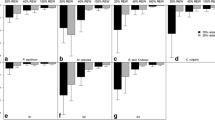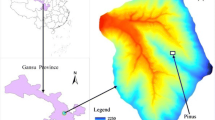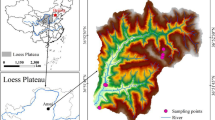Abstract
Precipitation that is intercepted by vegetation is generally considered as lost to the terrestrial hydrological cycle. However, if it is absorbed by the plants or reduces their transpiration, the intercepted water contributes positively to forest hydrology. The aim of this study was to investigate the absorption of intercepted water by a conifer and an angiosperm tree species. Pots of 2–3-year-old plants of × Cupressocyparis leylandii and Quercus robur were wrapped in plastic bags to exclude stemflow and throughfall from their water supply. Samples of both species were conditioned to two levels of aboveground wetting (sprinkled or un-sprinkled) and two levels of soil moisture (dry or moist). The periodical sprinkling with water droplets, lasting 5 h during two nights and 10 h in 1 day, ensured continuous aboveground wetting of plants during these periods. Weight changes of the plants were monitored after air drying in darkness for 3 h and wiping off any remaining surface water. Absorption of intercepted water was apparent for both species at night, when transpiration was close to zero. During the day, sprinkled plants of Q. robur had reduced rates of transpiration. For C. leylandii on dry soil sprinkling reduced water consumption during the first 24 h by 9%, while for Q. robur, the reductions were 46% and 27% for plants on dry and moist soils, respectively. These reductions in water consumption following sprinkling indicate that transpiration reduction and absorption of intercepted water deserve attention in studies of forest hydrology.

Similar content being viewed by others
References
Aslyng HC (1976) Klima, Jord og Planter. Kulturteknik 1, 5th edn. DSR Forlag, Royal Veterinary and Agricultural, Copenhagen
Berry ZC, Hughes NM, Smith WK (2014) Cloud immersion: an important water source for spruce and fir saplings in the southern Appalachian Mountains. Oecologia 174:319–326. https://doi.org/10.1007/s00442-013-2770-0
Berry ZC, Emery NC, Gotsch SG, Goldsmith GR (2019) Foliar water uptake: processes, pathways, and integration into plant water budgets. Plant, Cell Environ 42:410–423
Bhatt PN, Lahiri AN (1964) Some evidence of foliar absorption of water in a xeric tree, Prosopis spicigera. Die Naturwissenschaft 51:341–342
Breshears DD, McDowell NG, Goddard KL, Dayem KE, Martens SN, Meyer CW, Brown KM (2008) Foliar absorption of intercepted rainfall improves woody plant water status most during drought. Ecology 89(1):41–47
Burgess SSO, Dawson TT (2004) The contribution of fog to the water relations of Sequoia Sempervirens (D. Don): foliar uptake and prevention of dehydration. Plant, Cell Environ 27:1023–1034. https://doi.org/10.1111/j.1365-3040.2004.01207.x
Burkhardt J (2010) Hygroscopic particles on leaves: nutrients or desiccants? Ecol Monogr 80:369–399
Burkhardt J, Basi S, Pariyar S (2012) Hunsche M (2012) Stomatal penetration by aqueous solutions – an update involving leaf surface particles. New Phytol 196:774–787. https://doi.org/10.1111/j.1469-8137.2012.04307.x
Carlyle-Moses DE, Gash JHC (2011) Rainfall interception loss by forest canopies. In: Levia DF, Carlyle-Moses DE, Tanaka T (eds) Forest hydrology and biogeochemistry, ecological studies, vol 216. Springer, New York, pp 407–443. https://doi.org/10.1007/978-94-007-1363-5_20
Daum CH (1967) A method for determining water transport in trees. Ecology 48:425–431
Delfs J (1967) Interception and stemflow in stands of Norway Spruce and Beech in West Germany. In: Lull HW, Sopper WE (eds) International symposium on forest hydrology. Pergamon Press, Oxford, pp 179–185
Dunkerley DL (2009) Evaporation of impact water droplets in interception processes: historical precedence of the hypothesis and a brief literature overview. J Hydrol 376:599–604. https://doi.org/10.1016/j.jhydrol.200908.004
Earles MJ, Sperling O, Silva LCR, McElrone AJ, Brodersen CR, North MP, Zwienieki MA (2016) Bark water uptake promotes localized hydraulic recovery in coastal redwood crown. Plant, Cell Environ 39:320–328. https://doi.org/10.1111/pce.12612
Eller CB, Lima AI, Oliveira RS (2013) Foliar uptake of fog water and transport belowground alleviates drought effects in the cloud forest tree species, Drimys brasiliensis (Winteraceae). New Phytol 199:151–162. https://doi.org/10.1111/nph.12248
Gessner F (1956) Die Wasseraufnahme durch Blätter und Samen. Handbuch der Pflanzen Physiologie, vol 3. Springer, Berlin, pp 215–246
Goldsmith GR (2013) Changing directions: the atmosphere-plant-soil continuum. Commentary. New Phytol 199:4–6
Goldsmith GR, Matzke NJ, Dawson TE (2013) The incidence and implications of clouds for cloud forest plant water relations. Ecol Lett 16:307–314. https://doi.org/10.1111/ele.12039
Goldsmith GR, Lehmann MM, Cernusak LA, Arend M, Siegwolf RTW (2017) Inferring foliar water uptake using stable isotopes of water. Oecologia 184:763–766. https://doi.org/10.1007/s00442-017-03917-1
Grieve AM, Pitman MG (1978) Salinity damage to Norfolk Island pines caused by surfactants. III. Evidence for stomatal penetration as the pathway of salt entry to leaves. Aust J Plant Physiol 5:397–413
Guire KJ, Likens GE (2011) Historical roots of forest hydrology and biogeochemistry. In: Levia DF, Carlyle-Moses DE, Tanaka (eds) Forest hydrology and biogeochemistry, ecological studies, vol 216. Springer, New York, pp 3–26. https://doi.org/10.1007/978-94-007-1363-5_1
Herbst M, Rosier PTV, McNeil DD, Harding RJ, Gowing DJ (2008) Seasonal variability of interception evaporation from the canopy of a mixed deciduous forest. Agric For Meteorol 148:1655–1667
Hultine KR, Williams DG, Burgess SSO, Keefer TO (2003) Contrasting patterns of hydraulic redistribution in three desert phreatophytes. Oecologia 135:167–175. https://doi.org/10.1007/s00442-002-1165-4
Johnson MS, Jost G (2011) Ecohydrology and biogeochemistry of the rhizosphere in forested ecosystems. In: Levia DF, Carlyle-Moses DE, Tanaka T (eds) Forest hydrology and biogeochemistry, ecological studies, vol 216. Springer, New York, pp 483–498. https://doi.org/10.1007/978-94-007-1363-5_24
Johnson MS, Lehmann J (2006) Double-funneling of trees. Stemflow and root-induced preferential flow. Ecoscience 13(3):324–333. https://doi.org/10.2980/i1195-6860-13-3-324.1
Johnston RD (1964) Water relations of Pinus radiata under plantation conditions. Aust J Bot 12:111–124
Kerstiens G (1996) Diffusion of water vapour and gases across cuticles and through stomatal pores presumed closed. In: Kerstiens G (ed) Plant cuticles. An integrated functional approach. Bios Scientific Publishers Ltd., Oxford, pp 121–134
Kramer PJ (1969) Plant and soil water relationships: a modern synthesis. McGraw-Hill Book Company, New York, p 482
Lehmann MM, Goldsmith GR, Schmid L, Gessler A, Saurer M, Siegwolf RTW (2018) The effect of 18O-labelled water vapour on the oxygen isotope ratio of water and assimilates in plants at high humidity. New Phytol 217:105–116. https://doi.org/10.1111/nph.14788
Levia DF, Carlyle-Moses D, Tanaka T (eds) (2011) Forest hydrology and biogeochemistry. Synthesis of past research and future directions. Ecological studies, vol 216. Springer, New York, p 740. https://doi.org/10.1007/978-94-007-1363-5
Limm EB, Simonin KA, Bothman AG, Dawson TE (2009) Foliar water uptake: a common water acquisition strategy for plants of the redwood forest. Oecologia 161:449–459. https://doi.org/10.1007/s00442-009-1400-3
Oliveira RS, Dawson TE, Burgess SSO, Nepstad DC (2005) Hydraulic redistribution in three Amazonian trees. Oeologie 145:354–363. https://doi.org/10.1007/s00442-005-0108-2
Prieto I, Armas CA, Pugnaire FI (2012) Water release through plant roots: new insights into its consequences at plant and ecosystem level. New Phytol 193:830–841
Raeder-Roitzsch JE (1968) Watershed management. Lectures at the Pakistan Forest College, Peshawar
Schönherr J, Bukovac MJ (1972) Penetration of stomata lipids—dependence on surface tension, wettability, and stomatal morphology. Plant Physiol 49:813–819
Schubert A (1939) Untersuchungen über den Transpirationsstrom der Nadelhölzer und den Wasserbedarf von Fichte und Lärche. Tharandter Forstliches Jahrbuch 90:821–883
Slatyer RO (1956) Absorption of water from atmospheres of different humidity and its transport through plants. Aust J Biol Sci 9:552–558
Slatyer RO (1967) Plant–water relationships. Academic Press, London, p 366
Staelens J, Herbst M, Hölscher D, Schrijver AD (2011) Seasonality of hydrological and biogeochemical fluxes. In: Levia DF, Carlyle-Moses DE, Tanaka T (eds) Forest hydrology and biogeochemistry, ecological studies, vol 216. Springer, New York, pp 521–539. https://doi.org/10.1007/978-94-007-1363-5_26
Stålfelt MG (1944) Granens vattenförbrukning och dess inverkan på vattenomsättningen i Marken. Kungliga Lantbruksakademiens Tidskrift, Stockholm
Stone EC (1958) Dew absorption by conifers. In: Thimann KV (ed) Physiology of forest trees. Ronald Press, New York, pp 125–151
Tanaka T (2011) Effects of the canopy hydrologic flux on groundwater. In: Levia DF, Carlyle-Moses DE, Tanaka T (eds) Forest hydrology and biogeochemistry, ecological studies, vol 216. Springer, New York, pp 521–539. https://doi.org/10.1007/978-94-007-1363-5_25
Acknowledgements
Peter de Neergaard Simonsen inspired the initiation of experiments. The authors are indebted to Lars Graudal, Per Gundersen, Jacob Stokholm Kudsk, Henrik Skovgård and Ole Zethner for advice and critical reviews of earlier drafts. The paper was greatly improved by suggestions of the anonymous reviewers as well as by the contributions of Megan Somers.
Author information
Authors and Affiliations
Corresponding author
Additional information
Communicated by Christian Ammer.
Publisher's Note
Springer Nature remains neutral with regard to jurisdictional claims in published maps and institutional affiliations.
Electronic supplementary material
Below is the link to the electronic supplementary material.
Rights and permissions
About this article
Cite this article
Jensen, A.M., Mintschenko, H. & Ræbild, A. Transpiration reduction and absorption of intercepted water in Leyland cypress (× Cupressocyparis leylandii) and European common oak (Quercus robur). Eur J Forest Res 139, 585–593 (2020). https://doi.org/10.1007/s10342-020-01271-x
Received:
Revised:
Accepted:
Published:
Issue Date:
DOI: https://doi.org/10.1007/s10342-020-01271-x




